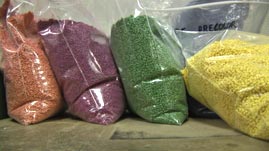Polymers are large molecules that are created by joining together smaller molecular units, called monomers. The term plastics encompasses a range of polymer materials that can be manipulated and molded for a wide variety of uses. There are two main types of plastics: thermoplastics and thermosets. The majority of plastics are thermoplastics, which are polymers composed of long chains of monomers and are meltable. In other words, they can be heated and reshaped repeatedly. In contrast, thermosets are composed of networks of monomers connected in two or three dimensions (as opposed to one-dimensional chains). Thermosets cannot be remelted, meaning that once the material is set and formed, it cannot be heated again without being destroyed.
Most manufactured plastics are carbon based and derived from coal, oil, or natural gas. However, the carbon can also be derived from renewable materials, such as bacteria and plants. Carbon atoms connect to other elements (such as chlorine, fluorine, hydrogen, nitrogen, and sulfur) to form groups of atoms—monomers. Through the process of polymerization, chemical reactions link many monomers together to form a polymer.
Different types of polymers have different properties, depending on the elements involved and the way in which they are connected. For example, polyethylene, composed of carbon and hydrogen atoms, is a common polymer with a huge array of everyday applications. When polyethylene strands are closely packed together in a linear arrangement, they produce high-density polyethylene (HDPE), which is fairly hard, chemically resistant, and can withstand relatively high temperatures. Milk jugs, laundry detergent bottles, fuel tanks, and furniture are commonly made of HDPE. Alternatively, when polyethylene strands are more loosely organized, they produce low-density polyethylene (LDPE), which is softer, more flexible, and has a lower melting point. LDPE is often used for food containers and storage bags, shrink wrap, and trash bags.
Another popular polymer with a similar name, polyethylene terephthalate (PET), is made of carbon, hydrogen, and oxygen atoms. Because of its clarity, strength, and gas and moisture resistance, PET is commonly used to make soda and water bottles, Mylar film, and synthetic fibers such as polyester and fleece. In sum, different combinations of monomers can create polymers customized for the specific needs of a product. Furthermore, the properties of a particular polymer can be modified by additives such as foaming agents, antimicrobials, flame retardants, reinforcing materials, and colorants. As a result, there is an endless variety of plastics that can be made for a seemingly limitless number of uses.

 Teachers' Domain is proud to be a Pathways portal to the National Science Digital Library.
Teachers' Domain is proud to be a Pathways portal to the National Science Digital Library.